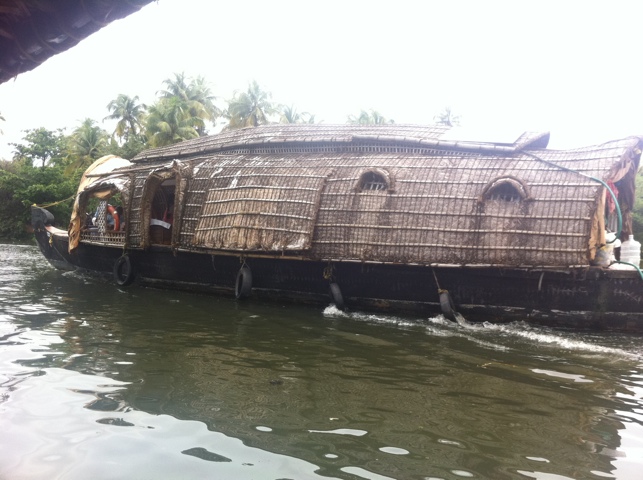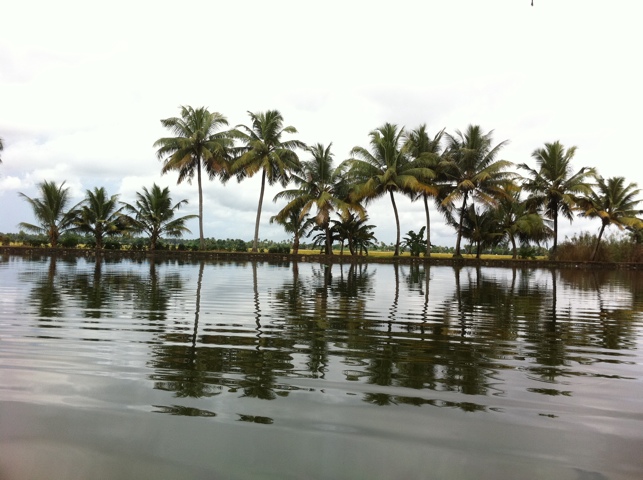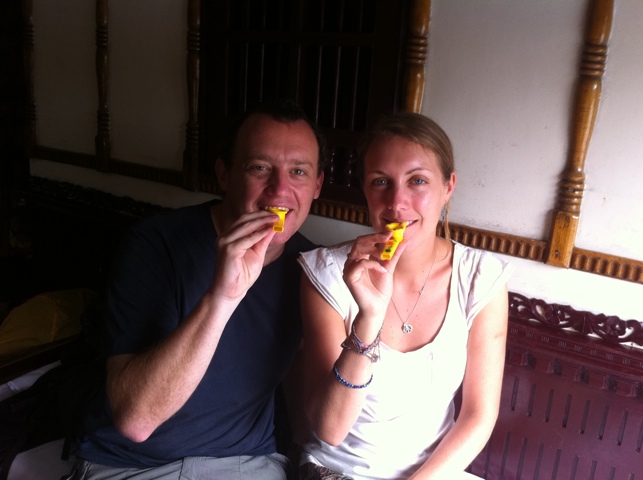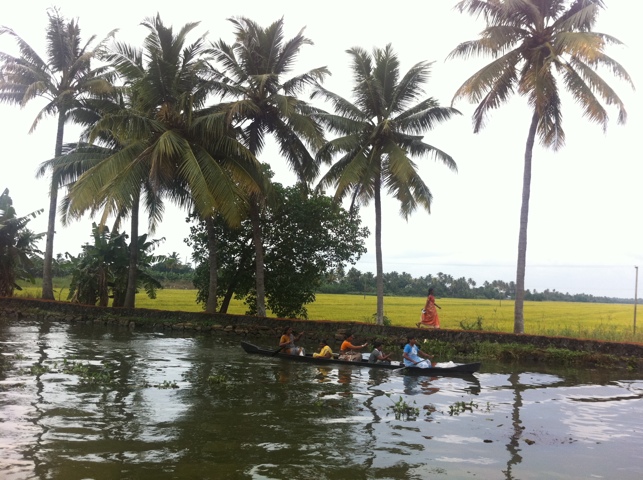We arrived in the southern state of Kerala to a thunderous welcome – a rainstorm. It was a bit of a shock for both of us, the first rain we’d seen in nearly a month in India and a refreshing reminder that this is the wettest state in the country.
The city of Alleppey sits nestled on the west coast astride a pair of canals between the beach and the inland waterways known as the backwaters. In lush contrast to the north, and particularly the parched and desert-like Rajasthan, everything is green and it feels like a tropical paradise: palm trees silhouetted against the sky, coconuts growing above us, and huge bunches of tiny bananas on the table in our guest house, freshly picked from the garden.
It’s always a bit strange arriving at a place in the dark – and especially in the pouring rain. We spent a difficult half hour searching the dimly-lit puddle-filled streets for somewhere to eat (and succeeded), before taking a fun rickshaw journey home the way we’d come, now totally unrecognisable in the gloom of the night. It was a memorable experience, with us shouting overconfident encouragement to the driver – “just a little bit further now” – as we jolted and splashed our way in the right direction but without the faintest clue as to why we hadn’t seen our place yet. As it turned out, we’d walked A Long Way on the trip into town and hadn’t realised. Fortunately despite not being able to agree a price up front (hard to do without a clear destination!), it only cost us 40 rupees, or 60p.
We spent a couple of nights resting from our journey and staying in a cute ‘cottage’ in the back garden of a house, bordered by paddy fields and narrow waterways. We even had our own veranda from which we could sit out and admire the fireflies at night, their lights blinking on and off slowly like tiny indicators in the dark. It was amazing as the darkness closed in around us and we could steadily see more and more flashing flying lights around us, blazing erratic trails through the air. Unfortunately they were also accompanied by swarms of mosquitos who thrive on the abundant freshwater – and so we had to beat a hasty retreat into the mosquito net protection of inside.
We spent a quiet day wandering round town (much less murky in the sunlight) and made it to the beach, where a few cafes look out over the grey-yellow sand to the dilapidated old pier and the ocean beyond. The rusting black silhouette reminded me of the West Pier in Brighton, a monument to better days – and presumably a time when this place was a teeming resort.
Kerala’s main fame these days is as home to the backwaters, a set of rivers and lakes that stretch for miles inland. This is now a big tourist industry, with some 500 houseboats available to rent in Alleppey alone. It’s also something my Dad did when he visited Kerala years ago – and that we were keen to try for ourselves.

I think Laura put it best when she described the houseboats as “like wicker chairs on water” – from a distance it looks like they’re made solely from woven bamboo, with associated concerns about their seaworthiness. Fortunately, up close it becomes apparent that they have solid metal frames, even if this somewhat dilutes the aesthetic. They’re also not quite the romantic delicate boats we’d envisaged in our minds – these things are bamboo-coated juggernaughts, many with multiple en-suite double bedrooms, air conditioning, a second story, and satellite TV to cap it off. It did feel slightly like a traffic jam on the M25 as we first set off, a long tailback of boats all heading in the same direction, chugging along slowly together while spluttering smoke from their exhausts. Fortunately, we soon reached a huge lake, and the boats all scattered in different directions, peace and tranquility restored.
We’d hired a boat from our guest house which we were pleased was smaller than most, with just a twin room, bathroom, kitchen and deck under cover from which we could watch the passing scenery. Nonetheless, even at this scale it was a world apart from the narrowboats we’ve holidayed on in the UK, where a boat the same size would easily sleep 12. On those, everything – beds, seats, to toilets and showers – is in miniature to make the boat smaller. Here we had full size fittings, and space on deck for a dining table, actual wicker chairs, and also deck chairs to recline in! The boat hire also comes with a three man crew who prepared us delicious food for the three meals we ate on board. It’s no wonder this is the most expensive thing we’ve done in India.

The backwaters themselves provide a serene view on waterside village life, with women washing clothes, children splashing, and men naturally sitting around chatting on the various boat jetties. I don’t however think there’s much justification to the phrase ‘virtually untouched’ – for even here there are clear signs of modernity, from the woven white plastic sacks that people have reused to give their fences more privacy to the electricity pylons and occasional sounds of kids watching the TV. As we moored up for the night in the early evening, we went for a wander through the village alongside us, meeting many smiling faces along the narrow pathways. Despite the significant tourism in the area, we were still a novelty, with parents calling out to their kids to come and watch us white people go past. We soon built up a crowd of jostling but timid youngsters around us, although sadly our interaction was limited to the ubiquitous plea from
them of “One pen, one pen?”
Our night sleeping on the water wasn’t entirely without incident – for as we found to our surprise at about 1am, we had a stowaway! We were both woken in our beds by the sound of something gnawing loudly, coming from the direction of our feet. It was loud, and we both sat there for a bit, adrenaline pumping, trying to work out what on earth it could be. A rat? A man-eating spider? An alligator?! It was with some trepidation that I picked up the water bottle and left the safety of the mosquito net cage to take on whatever was dining at our expense.
It soon became clear – but somewhat more puzzling – that the sound wasn’t coming from where our bags lay on the floor, but instead from higher up, somewhere above the door leading into the bathroom. With nothing obvious on our side, we concluded that the killer foe must instead be perched above the inside of the door, ready to pounce on whoever made the next toilet trip. As we listened carefully, I swear I could hear it sharpening its fangs for the upcoming battle. With Laura briefed on what my dying words were to be, the door was opened, to reveal the true horror of what lay inside…
Nothing! It seems that our stowaway must have been a mouse who’d made it into the inch-thick cavity between the two walls and was happily munching away at the tasty wood of the boat. The large hardboard walls were acting as a speaker cone, amplifying the sound and making it sound much larger than it really was. After enough thumps on the wall to wake half the village nearby, it finally stopped nibbling and scurried off, leaving us to try to get back to sleep in our alert state and hope it didn’t return for desert. Fortunately, it didn’t!

Our final day in Alleppey left us with some time to kill after departing the boat at 9am, and so we spent a tranquil couple of hours on a much smaller ‘canoe’ boat (not an actual canoe), traversing some narrower waterways and appreciating the beauty of the area from closer up than our houseboat had permitted. It was a great finish to our time on the water – a highly recommended excursion for anyone visiting the area!
Simon

